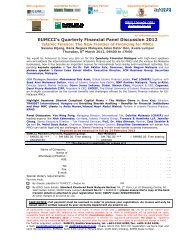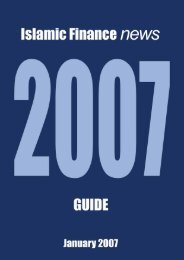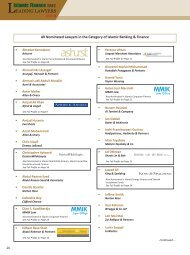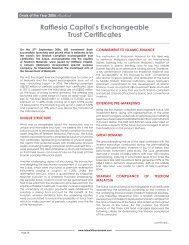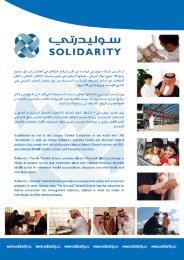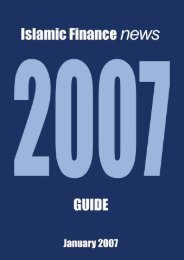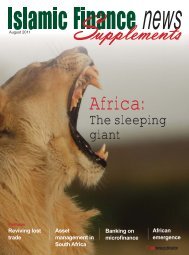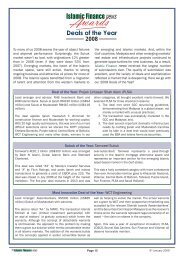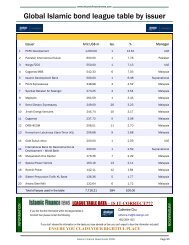legal guide09.indd - Islamic Finance News
legal guide09.indd - Islamic Finance News
legal guide09.indd - Islamic Finance News
Create successful ePaper yourself
Turn your PDF publications into a flip-book with our unique Google optimized e-Paper software.
Developments in <strong>Islamic</strong> Energy <strong>Finance</strong> —<br />
The Middle East<br />
By Craig Nethercott and Mohammed Al Sheikh<br />
In 2004, the Qatargas II LNG project achieved<br />
financial close on about US$500 million Istisna/Ijarah<br />
financing for part of the US$6.5 billion Qatargas II<br />
LNG facilities. <strong>Islamic</strong> financing did not feature in the<br />
subsequent Qatari oil and gas financings.<br />
The Qatargas <strong>Islamic</strong> structure, which was itself based<br />
on developments in the UAE ADWEA power deals,<br />
was later followed in Oman — the Sohar aluminium<br />
smelter, in Saudi Arabia — the Saudi Aramco/<br />
Sumitomo Chemical joint venture PetroRabigh in<br />
the amount of US$600 million and later in the SABIC<br />
Kayan project for a significant US$1.6 billion.<br />
In large part, these financings did not provide the<br />
all-important “additionality” to funding sources.<br />
Commercial banks split their participation between<br />
commercial and <strong>Islamic</strong> windows. The additional<br />
dollars from the dedicated <strong>Islamic</strong> finance institutions<br />
were not perceived as justifying the time and cost for<br />
development of the <strong>Islamic</strong> finance participation.<br />
These path finding <strong>Islamic</strong> project financings<br />
arguably had more to do with the political desire for<br />
the involvement of <strong>Islamic</strong> financings in projects than<br />
the fundamental need to establish a fully-funded<br />
financing plan. While the <strong>Islamic</strong> financing market<br />
has achieved greater involvement in non-energyrelated<br />
project financings in the Middle East since<br />
2004, the large energy projects have been financed<br />
primarily in the non-<strong>Islamic</strong> banking market.<br />
Fast forward five years and the project financing<br />
market looks very different from the heady days of<br />
2004-2007. Crude oil pricing is at nearly half the<br />
levels achieved in 2007. Project finance loan volumes<br />
are at 2005 levels based upon some statistics. Many<br />
of the major non-<strong>Islamic</strong> banking participants have<br />
withdrawn from the market or are participating<br />
at much lower levels of commitment. The recent<br />
distressed restructurings in the Middle East have<br />
also weighed upon regional and international bank<br />
appetite.<br />
The one silver lining in an otherwise gloomy<br />
assessment is that pricing, one of the main deterrents<br />
to <strong>Islamic</strong> bank participation in low margin energy<br />
financings prior to the credit crunch, has improved<br />
“marginally”.<br />
The reduction in the availability of non-<strong>Islamic</strong><br />
bank financing and the slump in crude oil pricing<br />
means that the monster-sized energy projects under<br />
development will have to look more closely at <strong>Islamic</strong><br />
financing participation in financing plans. Financing<br />
a multi-billion dollar project in today’s markets will<br />
require more creativity than in the 2004 to 2007<br />
period.<br />
The Istisna/Ijarah structures used in the earlier<br />
Qatargas/Rabigh/Kayan string of financings will still<br />
form an important part of the financing plans for the<br />
new energy projects coming on stream in the Middle<br />
East.<br />
Formerly the Istisna/Ijarah <strong>Islamic</strong> bank participations<br />
in energy project involved many of the international<br />
bank participants splitting the exposure between<br />
non-<strong>Islamic</strong> bank participation and <strong>Islamic</strong><br />
participation through their <strong>Islamic</strong> banking windows.<br />
The involvement of the non-<strong>Islamic</strong> banks through<br />
their <strong>Islamic</strong> windows can be expected to decline.<br />
The emergence of new <strong>Islamic</strong> banks and the<br />
entrance of the more established institutions in the<br />
project finance market will offset the disappearance<br />
of the <strong>Islamic</strong> window participants to some degree.<br />
Although there is significantly more <strong>Islamic</strong> bank<br />
capacity to participate in transactions than five years<br />
continued....<br />
50



